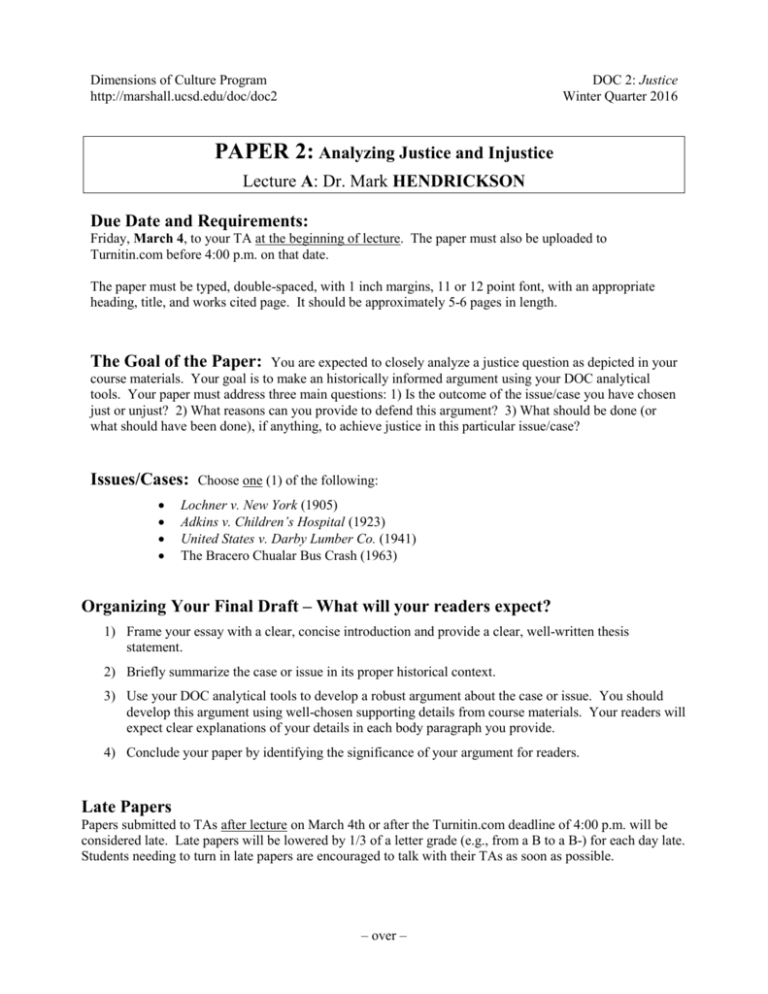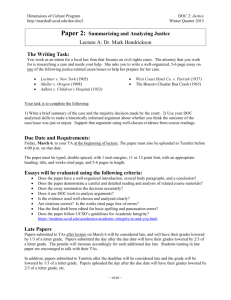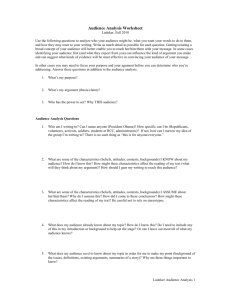PAPER 2: Analyzing Justice and Injustice Lecture A: Dr. Mark
advertisement

Dimensions of Culture Program http://marshall.ucsd.edu/doc/doc2 DOC 2: Justice Winter Quarter 2016 PAPER 2: Analyzing Justice and Injustice Lecture A: Dr. Mark HENDRICKSON Due Date and Requirements: Friday, March 4, to your TA at the beginning of lecture. The paper must also be uploaded to Turnitin.com before 4:00 p.m. on that date. The paper must be typed, double-spaced, with 1 inch margins, 11 or 12 point font, with an appropriate heading, title, and works cited page. It should be approximately 5-6 pages in length. The Goal of the Paper: You are expected to closely analyze a justice question as depicted in your course materials. Your goal is to make an historically informed argument using your DOC analytical tools. Your paper must address three main questions: 1) Is the outcome of the issue/case you have chosen just or unjust? 2) What reasons can you provide to defend this argument? 3) What should be done (or what should have been done), if anything, to achieve justice in this particular issue/case? Issues/Cases: Choose one (1) of the following: Lochner v. New York (1905) Adkins v. Children’s Hospital (1923) United States v. Darby Lumber Co. (1941) The Bracero Chualar Bus Crash (1963) Organizing Your Final Draft – What will your readers expect? 1) Frame your essay with a clear, concise introduction and provide a clear, well-written thesis statement. 2) Briefly summarize the case or issue in its proper historical context. 3) Use your DOC analytical tools to develop a robust argument about the case or issue. You should develop this argument using well-chosen supporting details from course materials. Your readers will expect clear explanations of your details in each body paragraph you provide. 4) Conclude your paper by identifying the significance of your argument for readers. Late Papers Papers submitted to TAs after lecture on March 4th or after the Turnitin.com deadline of 4:00 p.m. will be considered late. Late papers will be lowered by 1/3 of a letter grade (e.g., from a B to a B-) for each day late. Students needing to turn in late papers are encouraged to talk with their TAs as soon as possible. – over – Suggested Pre-Writing Timeline: Students are instructed to follow their TA’s instructions for any changes to this schedule. Week 7 Section 2 (2/18 or 2/19) Free-writing/ journaling on the paper. Week 8 Section 1 (2/23 or 2/24) Map or chart ideas; review notes. Week 8 Section 2 Week 9 Section 1 (2/25 or 2/26) (3/1 or 3/2) Write a rough draft Rough draft of of at least two body introduction and paragraphs. conclusion of the paper. Week 9 Section 2 (3/3 or 3/4) Final editing and revision work. Evaluation Rubric Grade Range “A” Range – Exceptional Response “B” Range – Strong and Successful Response “C” Range – Adequate Response “D” and Below Range – Incomplete Response Description The “A” essay demonstrates a thorough, complex, and especially insightful response to the topic and related course materials. In addition to addressing all parts of the prompt, it goes beyond the obvious response to the assignment and topic. The paper reflects a critical and comprehensive reading of the issue and related course materials. Evidence is well-chosen and explained in depth. The paper applies DOC tools correctly to enhance arguments and analysis. Proofreading and editing is superb and includes very few (if any) MLA or sentence-level errors. It stands above the rest for its organization, clarity and ideas. The “B” paper is a successful and complete response to the assignment. It addresses all parts of the prompt. It includes well-chosen evidence and analysis using DOC tools. However, there are a few places where these components could be explored with more depth, specificity, and/or accuracy to improve the paper. For example, the argument could be slightly more critical, or it could be organized in a clearer way to enhance reader comprehension. Perhaps DOC tools could be applied more successfully to develop the argument. Or, evidence could be better selected and/or explained for readers. Proofreading and editing is well done, with only a few minor issues. The “C” paper demonstrates an adequate response to the assignment. It addresses all parts of the prompt and has a clear argument, but there are a few areas for improvement. For example, the argument may be restricted to an overly obvious response. Evidence in a few paragraphs may not be as well-chosen or explained as necessary for reader comprehension. Perhaps there are a few paragraphs that rely on unsupported generalizations and/or unexplained supporting details. The paper reflects a limited engagement with readings and DOC tools and concepts. With a little more reading, review, revision and editing, and perhaps an office hour visit to the TA or lecturer, this could have been a “B” paper. Work that earns a grade below a “C” indicates that the paper is an incomplete response to the assignment. A paper in this range may struggle with some/all of the following: lacks a clear argument; addresses the wrong prompt; fails to follow all directions, fails to incorporate course readings and materials; does not use supporting details or evidence; has significant structural and distracting sentence-level errors. It may also contain evidence of plagiarism. A paper in this range could have strongly benefited from: additional planning and outlining work; office hour visits with the TA; Writing Center appointments; and/or greater class participation.







